MARKET OVERVIEW
The global interior fit-out market will delineate the business dedicated to converting interior spaces into utilitarian and aesthetically sophisticated environments within commercial, residential, hospitality, retail, healthcare, and institutional environments. The market will exist at the intersection of design realization, space optimization, and technical detail, designing interiors to address particular usage and branding requirements. The sector will not simply provide visual enhancements; it will choreograph the interface between construction components like partition systems, floors, ceilings, furniture, lighting, and mechanical-electrical systems to realize tailored spatial solutions.
Being different from conventional building sectors, the global interior fit-out market will concentrate on subsequent structural phases of building projects, where bare shells are transformed into functional environments. Its scope will stretch beyond aesthetic enhancements, emphasizing alignment with functional intent, user behavior, regulatory requirements, and sustainability targets. Whether it's a luxury hotel in Dubai, a high-tech workspace in Tokyo, or a flagship store in London, the market will drive the execution of space strategies through layered activities involving planning, procurement, material innovation, and real-time site coordination.
The market's impact will reach both new builds and refurbs, adapting to fluid shifts in consumer values, brand image, and workspace functionality. Demand in the future will not just be created by physical structures but also by the way environments connect with human interaction, productivity, and cultural storytelling. There won't be interior spaces in isolation; they'll have to project company values, support digital integration, and meet changing safety requirements, particularly in public-access buildings. The global interior fit-out market will respond to these demands with a dynamic balance of architectural acumen and trade delivery.
Regionally across the world, local design sensibilities and project deadlines will be key in dictating material procurement, fit-out methods, and finishing levels. This will lead to a very fragmented but worldwide networked industry, wherein contractors, architects, designers, and suppliers work together in a series of activity streams ranging from planning to handover. Global Interior Fit-Out contractors will need to decipher spatial stories and translate them into functional specifications, juggling site conditions, lead times, client aspirations, and technical limitations at the same time.
Whereas most industries concentrate on product development, the global interior fit-out market will concentrate on spatial experience. Its result will be touchable and tangible from the feel of a wall finish to the sound of a ceiling grid. It will exist under fixed project timelines, budget limits, and design requirements, usually under severe coordination pressure. Over time, it will further develop with the integration of technologies such as Building Information Modeling (BIM), augmented reality visualization, and prefabricated systems, all of which will reduce execution to a flow but demand more acute technical management.
The destiny of the Global Interior Fit-Out industry will be its fine balance between design faithfulness and implementation effectiveness. While design standards continue to reach new heights and clients demand immersion in built spaces, this market will become the ultimate craftsman of architectural vision, rendering raw spaces real with accuracy, clarity, and intention.
Global interior fit-out market is estimated to reach $125,420.20 Million by 2032; growing at a CAGR of 8.3% from 2025 to 2032.
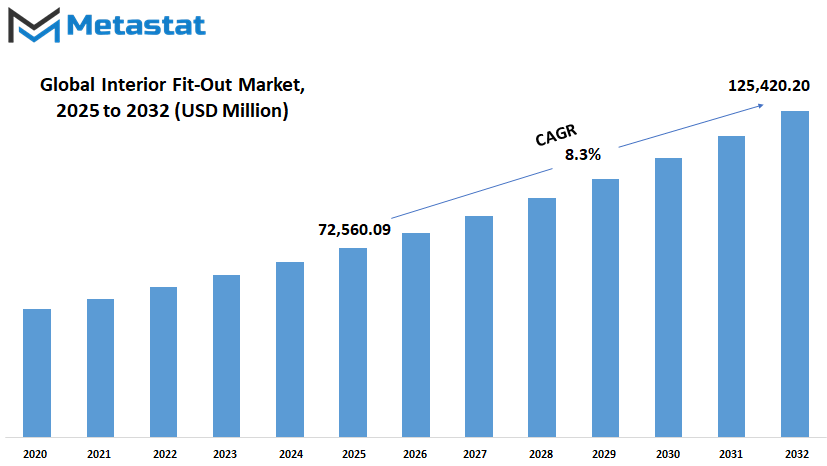
GROWTH FACTORS
The global interior fit-out market is expected to witness steady growth over the coming years. This growth will largely be driven by the increasing development of commercial real estate and the growing demand for personalized office environments. As businesses expand and aim to reflect their identity through their physical spaces, there is a rising need for interiors that cater to specific branding and functional requirements. This shift is pushing companies to invest in tailored fit-out solutions that can adapt to different industries, from tech start-ups to co-working hubs and corporate headquarters.
Luxury is also becoming a central focus, especially in residential and hospitality interiors. More individuals and property developers are opting for upscale designs that highlight comfort, aesthetics, and functionality. This trend is especially visible in high-end homes, hotels, and resorts, where interior design plays a major role in enhancing the overall experience. As a result, interior fit-out services are increasingly focused on offering unique design concepts and fine finishes, creating new demand segments within the market.
However, there are challenges that could slow down this growth. One of the main concerns is the rising cost of materials and labor. As the prices of raw materials fluctuate and skilled labor becomes harder to source, the total cost of interior fit-out projects continues to rise. These cost-related issues can lead to budget overruns and may discourage potential clients from moving forward with large-scale or customized fit-outs. Alongside this, disruptions in the global supply chain can cause significant delays in project timelines. Delayed deliveries of key materials or components can stall progress, impacting client satisfaction and long-term planning for service providers.
Despite these hurdles, the future holds strong potential for the global interior fit-out market. There is a growing push toward more sustainable and intelligent interiors. Clients are now seeking eco-friendly alternatives that not only reduce environmental impact but also offer modern tech integrations. Smart lighting, energy-efficient systems, and the use of recycled or low-impact materials are becoming more common. These evolving preferences are pushing industry players to innovate and offer solutions that combine design with technology and sustainability.
Looking ahead, the market will likely continue to grow as innovation aligns with client needs. With a focus on personalization, environmental responsibility, and tech-friendly spaces, the global interior fit-out market is set to shape how future spaces are built and experienced.
MARKET SEGMENTATION
By Style
The global interior fit-out market is moving toward a future shaped by lifestyle shifts, environmental awareness, and rapid technological development. As spaces continue to reflect the personality and needs of those who use them, the styles applied to interior fit-outs are becoming more than just aesthetic choices they are now connected to function, comfort, and long-term value. Each style, from modern and contemporary to traditional and eco-friendly, is expected to play a unique role in how the market grows in the coming years.
Modern and contemporary styles continue to lead with their focus on clean lines, open spaces, and practical materials. These designs will remain popular, especially in urban areas where simplicity and smart use of space are essential. As more people choose smaller living and working spaces, the demand for styles that make rooms feel larger and more breathable will rise. This shift will support growth in this part of the market, driven by young professionals and fast-moving urban lifestyles.
On the other hand, traditional and classic styles are likely to see steady interest. These designs hold emotional and cultural value, often tied to a sense of stability and comfort. Though not as fast-paced as modern trends, they offer a sense of luxury and permanence that appeals to homeowners and institutions wanting to maintain a lasting appearance. The future will likely see these styles updated with subtle changes that bring in modern features without losing their timeless character.
One of the most promising directions for the global interior fit-out market is the eco-friendly and sustainable style category. As climate concerns grow, so does the push for materials and practices that reduce harm to the environment. Future designs will likely include more recycled materials, energy-saving systems, and natural elements. Governments and organizations may also support this shift with policy changes and incentives. People will be more mindful of what they bring into their homes and offices, which will make sustainable interiors not just an option, but a standard.
Industrial and urban styles are also gaining traction, especially in refurbished spaces and converted buildings. Their raw look and use of exposed materials like brick, concrete, and steel make them cost-effective and visually striking. As cities grow and older buildings are repurposed, this design choice will likely become more common.
The future of the global interior fit-out market will not rely on one style alone. Instead, it will be shaped by how people live, what they value, and how their environments respond to those needs.
By Services
The global interior fit-out market is set to experience a strong shift as demand for customized and flexible spaces continues to grow. People are looking for environments that reflect their personality, brand, or way of life. This is pushing companies to think beyond traditional ideas of space planning. The need for more functional, comfortable, and well-designed interiors is growing not just in offices and homes, but also in hospitality, healthcare, and retail spaces. This shift is not a passing trend it’s a response to how people want to interact with the spaces they use every day. Whether it’s for work, relaxation, or public interaction, the design and feel of a space now matter more than ever.
Looking ahead, technology will play a larger role in how interior fit-out services are delivered. With smart materials and digital tools, companies will be able to offer more efficient solutions. For example, 3D visualization is making it easier for clients to see what the final results will look like before work even begins. This will lead to fewer changes during the process, saving time and money. The move towards sustainable solutions is also shaping the industry. People want eco-friendly materials, energy-saving systems, and waste-reducing methods. Interior fit-out services that can meet these expectations will stand out and gain more trust in the long run.
By services, the global interior fit-out market is broadly divided into Construction & Installation, Design & Consulting, and Other Services. Construction & Installation will keep leading in terms of value, as it includes the actual building and assembling of interiors. This part of the market often needs the most labor and resources. Design & Consulting, while smaller in scale, will become more important as clients ask for creative input and advice before starting a project. This part of the service helps make sure that the design fits both function and style. Other Services include maintenance, refurbishment, and space management. These will see more attention in the future as people look for ways to refresh spaces without starting from scratch.
As lifestyles change and the push for better spaces continues, the global interior fit-out market will move toward more tailored and forward-thinking solutions. The blend of design, technology, and personal preference will guide this market into a future shaped by both creativity and practical needs.
By Budget Range
The global interior fit-out market is gradually shaping the way people experience indoor spaces, not just in how they look but in how they feel and function. With growing demand for personal comfort, smart usage of space, and better working or living environments, this market is moving toward a more thoughtful and customer-focused approach. As more individuals and companies start paying attention to both design and function, interior fit-outs are no longer limited to decorative details. They now include everything from layout planning to smart solutions that meet modern needs.
In the future, the global interior fit-out market will likely grow steadily as more people around the world look for ways to improve their living or working spaces without building from scratch. This makes fit-outs a cost-effective and practical choice. Whether it's for homes, offices, hotels, or retail outlets, businesses will continue to turn to these services to keep their spaces up to date with style and technology.
By budget range, the market is often split into three groups: low budget, mid-range, and high-end luxury. Each segment meets the needs of different clients. Low budget fit-outs usually focus on function and value. They aim to give a decent finish within limited resources and are often chosen for rental properties, small businesses, or first-time homeowners. In contrast, the mid-range group balances quality and price. These fit-outs offer a better finish, improved materials, and design flexibility, often appealing to growing families or expanding companies who want more without going overboard. At the top end, high-end luxury fit-outs focus on premium materials, unique designs, and personalized experiences. These are chosen by people or businesses that want something truly standout and are ready to invest in creating a space that reflects a specific lifestyle or brand identity.
Technology will keep playing a bigger role in all budget ranges. Even low-budget projects will likely see the use of more durable and smart materials, while luxury ones may adopt AI-driven systems for lighting, climate, and security. This shift means that future fit-outs won’t only be about looks they will also help improve daily life in smarter and more sustainable ways.
With changing needs and growing awareness, the global interior fit-out market will continue to change how people think about and interact with their spaces, regardless of how much they choose to spend.
By Application
The global interior fit-out market is expected to see noticeable growth in the coming years. As more people shift their expectations toward modern and functional spaces, this market is likely to keep expanding. Changes in how people work, live, and learn are pushing forward new interior needs that go beyond just appearance. With rising awareness around comfort, productivity, and sustainable living, the demand for better interiors across sectors is becoming stronger.
One key area where this market is growing fast is in corporate offices. The nature of work is changing, and so are office spaces. Companies want workplaces that help employees focus, collaborate, and feel more comfortable. In the future, flexible layouts, smart lighting, and noise control features will be common in fit-out projects. This means there will be continued investment in upgrading office interiors to match new work habits.
The hospitality and leisure segment is also a major driver. Hotels, resorts, and entertainment venues are now expected to offer unique experiences. Fit-outs in this area will focus on creating inviting, personalized, and technology-rich environments. As tourism grows and travelers look for comfort mixed with novelty, businesses will need to redesign their interiors more often to stay attractive.
Healthcare is another sector where fit-outs will play an important role. With advancements in medical care and patient-centered services, hospitals and clinics are changing how they look and function. Future fit-outs in healthcare will focus on creating calm and efficient spaces, using materials and layouts that support hygiene and well-being. As healthcare services expand, so will the need for better-designed interiors that support both staff and patient needs.
In residential settings, people are showing more interest in interior fit-outs that reflect their personal style while also being practical. As living spaces become more compact, the use of smart storage and multi-functional design will grow. The push for home automation and eco-friendly materials will influence how homes are fitted out in the future.
Educational buildings are being reshaped as well. Schools and universities are turning to interior designs that support creativity and flexible learning. Open spaces, modern furniture, and improved lighting will become more common, helping to create better learning environments.
Other sectors like government buildings are also expected to invest in new fit-out projects. Whether it’s for better public service or energy savings, redesigning interiors will be part of long-term goals. Overall, the global interior fit-out market will continue to evolve, shaped by technology, changing habits, and a growing need for spaces that are both useful and inviting.
|
Forecast Period |
2025-2032 |
|
Market Size in 2025 |
$72,560.09 million |
|
Market Size by 2032 |
$125,420.20 Million |
|
Growth Rate from 2025 to 2032 |
8.3% |
|
Base Year |
2024 |
|
Regions Covered |
North America, Europe, Asia-Pacific Green, South America, Middle East & Africa |
REGIONAL ANALYSIS
The global interior fit-out market is shaped by regional needs, cultural preferences, and economic conditions that influence how spaces are designed and built. As the world continues to grow and change, different regions bring unique opportunities and challenges to this market. North America, led by the U.S., shows steady demand for modern and efficient interior spaces, especially in urban areas where commercial buildings are frequently updated. Canada and Mexico follow similar patterns, focusing on both residential and commercial upgrades to keep up with population growth and shifting work habits.
In Europe, countries like the UK, Germany, France, and Italy are placing greater focus on sustainable materials and energy-saving designs. This shift reflects a growing awareness of environmental concerns and stricter regulations. Across the rest of Europe, there’s a blend of traditional styles meeting modern solutions, driven by renovations in older buildings and a desire to preserve cultural identity while improving comfort and functionality. These trends are expected to continue, with technology becoming a bigger part of interior planning.
Asia-Pacific is set to be one of the most dynamic regions for the global interior fit-out market. India and China, with their large populations and rapid urban development, are seeing a rise in demand for residential, retail, and office space interiors. Japan and South Korea, known for their design innovation, are likely to continue leading in smart interiors that balance space-saving ideas with modern aesthetics. As more people move to cities across this region, the need for smart, stylish, and adaptable interiors will grow, making Asia-Pacific a key driver in the future of this industry.
In South America, Brazil and Argentina are emerging as important players. Although the pace of growth may vary, the demand for updated interiors in hospitality and retail sectors is expected to rise. These changes are largely influenced by tourism, economic development, and regional investment in infrastructure.
The Middle East and Africa region offers a different set of opportunities. GCC countries, especially the UAE and Saudi Arabia, are investing heavily in luxury and commercial spaces, making them strong markets for high-end interior projects. Egypt, South Africa, and other parts of the region are also gradually increasing their demand, driven by urban expansion and a rising middle class.
As time moves forward, the global interior fit-out market will keep adapting to regional needs, blending local preferences with global trends, and relying on innovation to meet the growing expectations of both businesses and individuals.
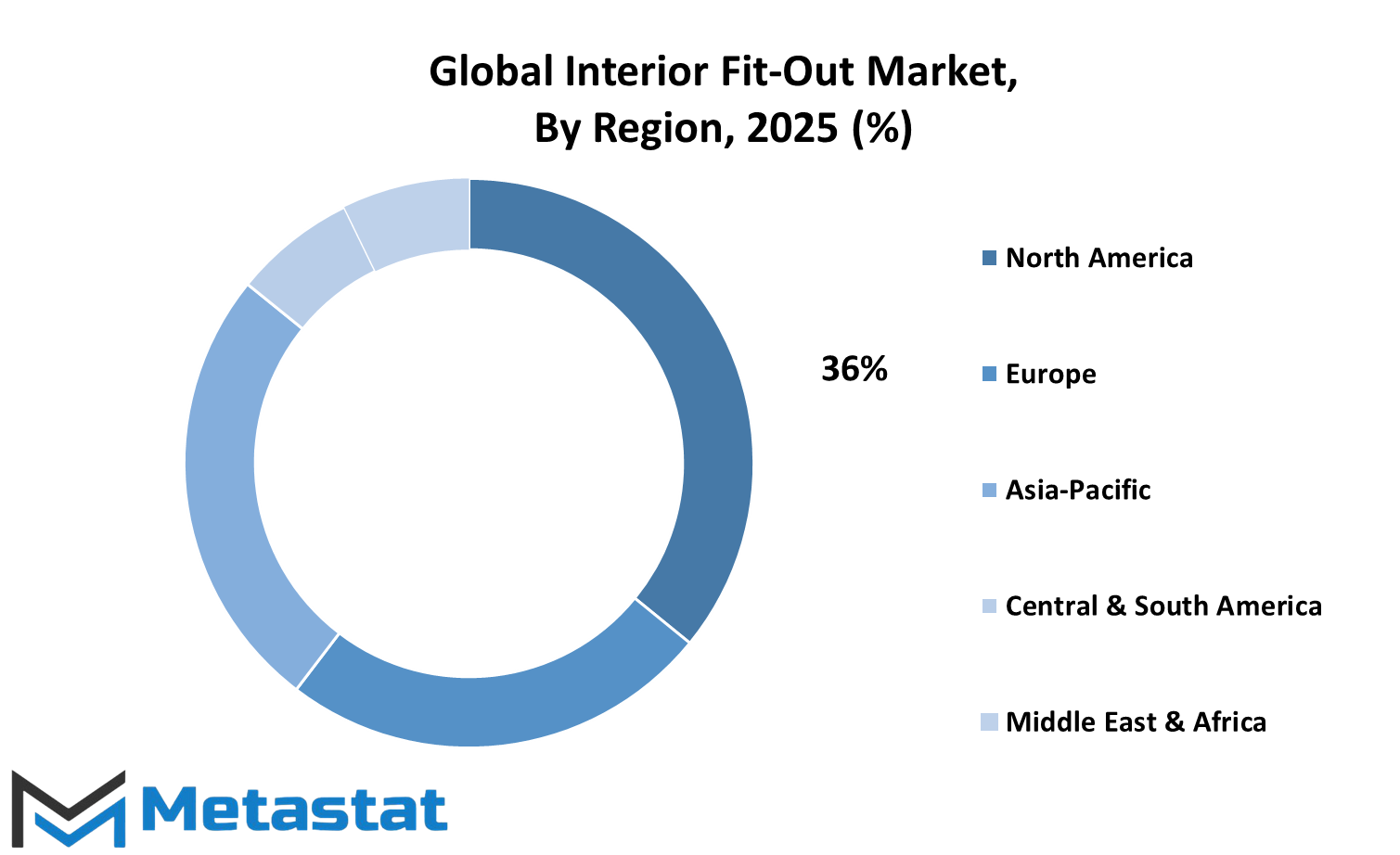
COMPETITIVE PLAYERS
The global interior fit-out market is expected to experience steady growth in the coming years as demand for innovative, comfortable, and purpose-driven spaces continues to rise. As people look for environments that support both function and aesthetics, companies are adjusting their strategies to stay ahead. This shift is not just about visual appeal but also about creating spaces that support productivity, wellness, and adaptability. The construction industry is embracing new trends, and fit-out solutions are becoming an important part of this transformation. These developments are being driven by growing expectations from clients in both the commercial and residential sectors, who now want more than just basic finishes they seek intelligent, customized, and long-lasting interior solutions.
In the global interior fit-out market, several competitive players are shaping the direction of growth through their strategic efforts and innovations. Companies such as AECOM BA, Al Habtoor Group, Arabtec Construction LLC, Arcadis, Balfour Beatty plc, CBRE, and Clark Construction Group are among those leading the way. They are actively refining their approaches by using modern technologies, sustainable materials, and energy-efficient processes. With urban development expanding and smart cities becoming more common, these companies are well-positioned to meet growing expectations.
Global players like Cushman & Wakefield, Depa Group, DPR Construction, Gensler, Gilbane Building Company, HBA, and HOK Group Inc continue to improve how they deliver projects. They are focusing on teamwork and technology to make the process smoother and more responsive to client needs. In addition, firms such as ISG plc, Jacobs Engineering Group Inc, JLL, Larsen & Toubro (L&T), and Lendlease Group are keeping pace by adjusting their strategies to offer more personalized fit-out services.
Firms including Linder Group, MACE, PCL Construction Enterprises, Perkins+Will, Skanska AB, Stantec, Structure Tone, Tetris, and Turner Construction Company are also playing key roles in shaping the future of this space. They recognize the importance of balancing creativity and function, and they are continually looking for new ways to improve the customer experience. In the coming years, their success will depend on how well they adapt to new expectations, respond to sustainable goals, and use technology to improve their processes.
As demands change and technology continues to evolve, the global interior fit-out market will likely attract more attention and investment. Competitive players who stay responsive and willing to adapt will find new ways to lead and grow in this expanding field.
Interior Fit-Out Market Key Segments:
By Style
- Modern & Contemporary
- Traditional & Classic
- Eco-Friendly & Sustainable
- Industrial & Urban
- Other Styles
By Services
- Construction & Installation
- Design & Consulting
- Other Services
By Budget Range
- Low Budget
- Mid-Range
- High-End Luxury
By Application
- Corporate Offices
- Hospitality and Leisure
- Healthcare
- Residential
- Educational
- Others (Government, etc.)
Key Global Interior Fit-Out Industry Players
- AECOM BA
- Al Habtoor Group
- Arabetc Construction LLC
- Arcadis
- Balfour Beatty plc
- CBRE
- Clark Construction Group
- Cushman & Wakefield
- Depa Group
- DPR Construction
- Gensler
- Gilbane Building Company
- HBA
- HOK Group Inc
- ISG plc
- Jacobs Engineering Group Inc
- JLL
- Larsen & Toubro (L&T)
- Lendlease Group
- Linder Group
- MACE
- PCL Construction ENterprises
- Perkins+Will
- Skansha AB
- Stantec
- Structure Tone
- Tetris
- Turner Construction Company
WHAT REPORT PROVIDES
- Full in-depth analysis of the parent Industry
- Important changes in market and its dynamics
- Segmentation details of the market
- Former, on-going, and projected market analysis in terms of volume and value
- Assessment of niche industry developments
- Market share analysis
- Key strategies of major players
- Emerging segments and regional growth potential



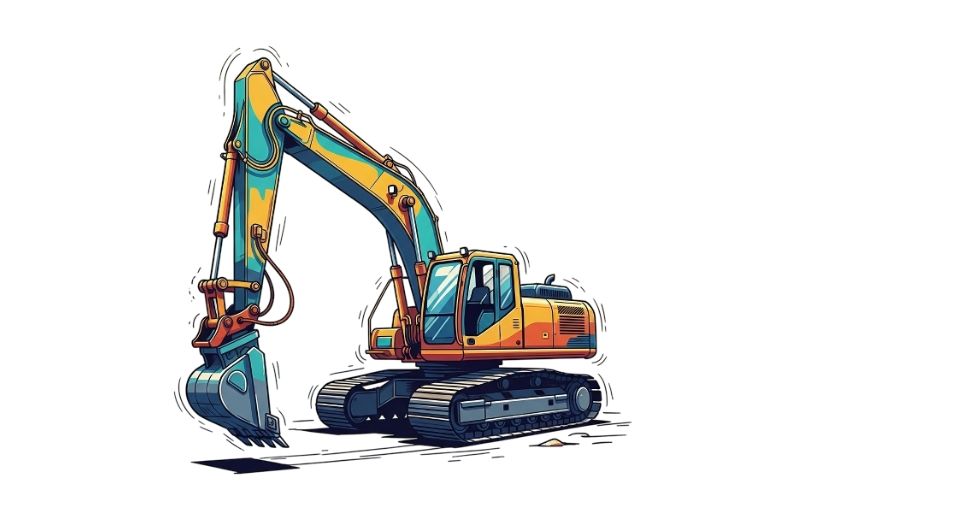
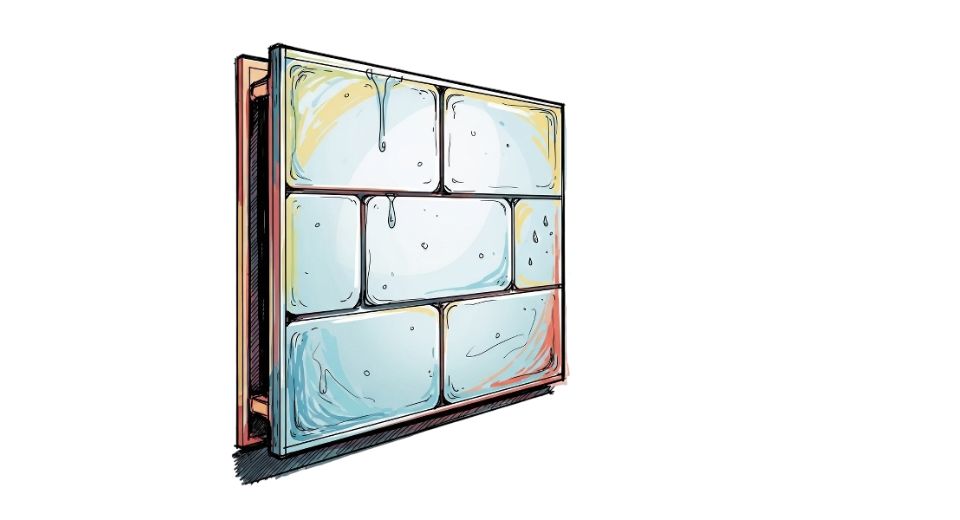

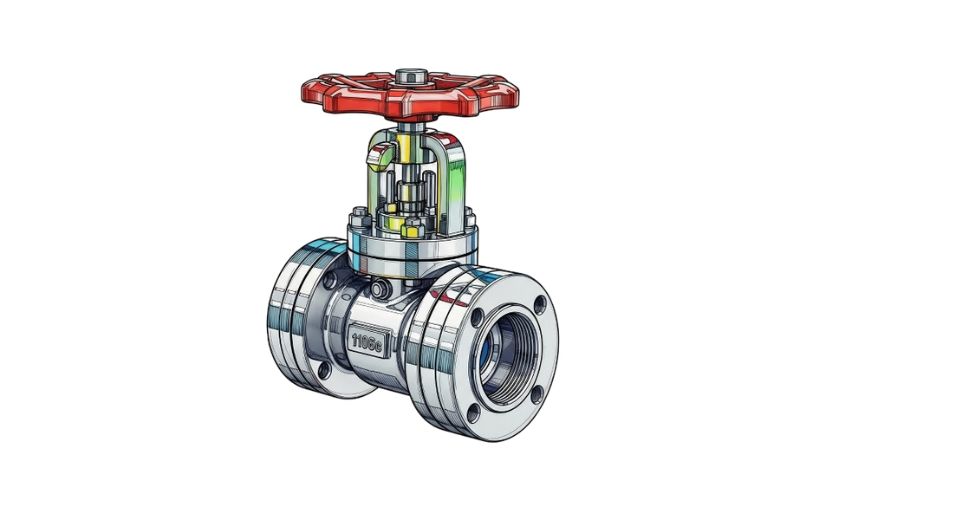

 US: +1 3023308252
US: +1 3023308252






